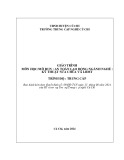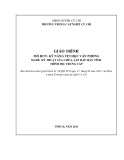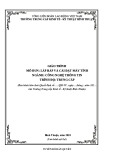
NKK-HUST
Kiến trúc máy tính
Thiết kế bộ xử lý
theo kiến trúc MIPS
Nguyễn Kim Khánh
Trường Đại học Bách khoa Hà Nội
Jan2015 Computer Architecture - MIPS 1

NKK-HUST
1. Thực hiện bộ xử lý MIPS cơ bản
2. Thiết kế khối datapath
3. Thiết kế control unit
4. Kỹ thuật đường ống lệnh
Nội dung
Jan2015 Computer Architecture - MIPS 2

NKK-HUST
1. Thực hiện bộ xử lý MIPS cơ bản
n Xem xét hai cách thực hiện bộ xử lý theo kiến
trúc MIPS:
n Phiên bản đơn giản
n Phiên bản được đường ống hóa (gần với thực tế)
n Chỉ thực hiện với một số lệnh cơ bản của
MIPS, nhưng chỉ ra hầu hết các khía cạnh:
n Các lệnh tham chiếu bộ nhớ: lw, sw
n Các lệnh số học/logic: add, sub, and, or, slt
n Các lệnh chuyển điều khiển: beq, j
Jan2015 Computer Architecture - MIPS 3

NKK-HUST
Tổng quan quá trình thực hiện các lệnh
n Hai bước đầu tiên với mỗi lệnh:
n Đưa địa chỉ từ bộ đếm chương trình PC đến
bộ nhớ lệnh, tìm và nhận lệnh từ bộ nhớ này
n Sử dụng các số hiệu thanh ghi trong lệnh để
chọn và đọc một hoặc hai thanh ghi:
n Lệnh lw: đọc 1 thanh ghi
n Các lệnh khác (không kể lệnh jump): đọc 2 thanh
ghi
Jan2015 Computer Architecture - MIPS 4

NKK-HUST
Tổng quan quá trình thực hiện các lệnh (tiếp)
n Các bước tiếp theo tùy thuộc vào loại lệnh:
n Sử dụng ALU hoặc bộ cộng Add để:
n Tính kết quả phép toán với các lệnh số học/logic
n So sánh các toán hạng với lệnh branch
n Tính địa chỉ đích với các lệnh branch
n Tính địa chỉ ngăn nhớ dữ liệu với lệnh load/store
n Truy cập bộ nhớ dữ liệu với lệnh load/store
n Lệnh lw: đọc dữ liệu từ bộ nhớ
n Lệnh sw: ghi dữ liệu ra bộ nhớ
n Ghi dữ liệu đến thanh ghi đích:
n Các lệnh số học/logic: kết quả phép toán
n Lệnh lw: dữ liệu được đọc từ bộ nhớ dữ liệu
Jan2015 Computer Architecture - MIPS 5
























![Bài giảng Tổ chức - Cấu trúc Máy tính II Đại học Công nghệ Thông tin (2022) [Mới Nhất]](https://cdn.tailieu.vn/images/document/thumbnail/2025/20250515/hoatrongguong03/135x160/8531747304537.jpg)

